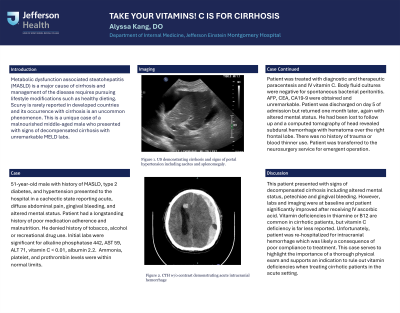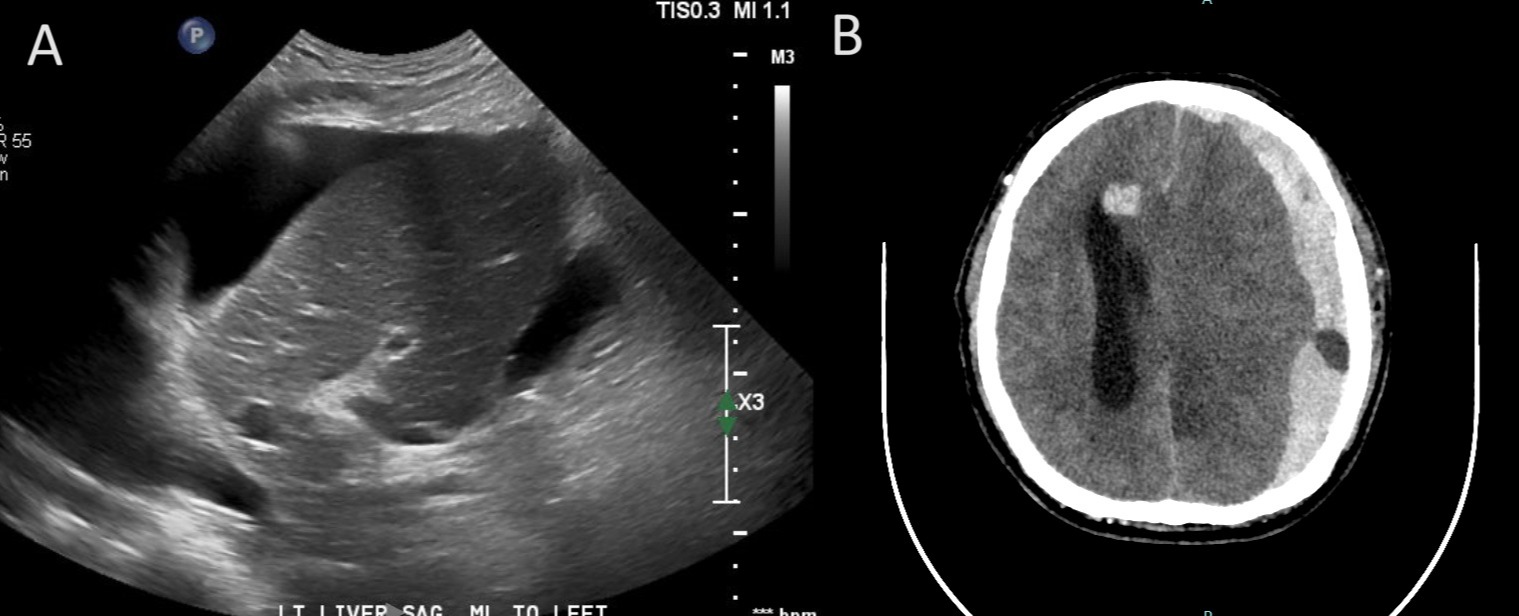Sunday Poster Session
Category: Liver
P1411 - Take Your Vitamins! C is for Cirrhosis
Sunday, October 27, 2024
3:30 PM - 7:00 PM ET
Location: Exhibit Hall E

Has Audio
.jpg)
Alyssa Kang, DO
Einstein Healthcare Network
East Norriton, PA
Presenting Author(s)
Alyssa Kang, DO
Einstein Healthcare Network, East Norriton, PA
Introduction: Metabolic dysfunction associated steatohepatitis (MASLD) is a major cause of cirrhosis and management of the disease requires pursuing lifestyle modifications such as healthy dieting. Scurvy is rarely reported in developed countries and its occurrence with cirrhosis is an uncommon phenomenon. We present a unique case of a malnourished middle-aged male who presented with signs of decompensated cirrhosis with unremarkable MELD labs.
Case Description/Methods: 51-year-old male with history of MASLD, type 2 diabetes, hypertension and poor medication compliance presented to the hospital in a cachectic state reporting acute, diffuse abdominal pain, gingival bleeding, and altered mental status. Labs were significant for alkaline phosphatase 442, AST 59, ALT 71, vitamin C < 0.01, albumin 2.2. Ammonia, platelet, and prothrombin levels were normal. Ultrasound of the abdomen demonstrated hepatic cirrhosis with evidence of portal hypertension including ascites and splenomegaly. He denied history of tobacco, alcohol or recreational drug use. Patient was treated with diagnostic and therapeutic paracentesis and intravenous (IV) vitamin C. Body fluid cultures were negative for spontaneous bacterial peritonitis. AFP, CEA, CA19-9 were unremarkable. Patient was discharged on day 5 of admission but returned one month later, again with altered mental status. Computed tomography of head revealed subdural hemorrhage with hematoma over the right frontal lobe. There was no history of trauma or blood thinner use. Patient was transferred to the neurosurgery service for emergent operation.
Discussion: Vitamin C deficiency is not uncommon among the geriatric group of hospitalized patients, especially in the setting of trauma or sepsis. And although vitamin deficiencies such as thiamine or B12 are common in cirrhotic patients, vitamin C deficiency is far less reported. Our patient presented with signs of decompensated cirrhosis such as petechiae, gingival bleeding, and altered mental status. However, labs and imaging proved otherwise and patient significantly improved after receiving IV ascorbic acid. Unfortunately, patient was re-hospitalized for intracranial hemorrhage which was likely a consequence of poor compliance to treatment. This case serves to highlight the importance of performing a thorough skin examination and considering ascorbic acid levels when treating cirrhotic patients in the acute setting.

Disclosures:
Alyssa Kang, DO. P1411 - Take Your Vitamins! C is for Cirrhosis, ACG 2024 Annual Scientific Meeting Abstracts. Philadelphia, PA: American College of Gastroenterology.
Einstein Healthcare Network, East Norriton, PA
Introduction: Metabolic dysfunction associated steatohepatitis (MASLD) is a major cause of cirrhosis and management of the disease requires pursuing lifestyle modifications such as healthy dieting. Scurvy is rarely reported in developed countries and its occurrence with cirrhosis is an uncommon phenomenon. We present a unique case of a malnourished middle-aged male who presented with signs of decompensated cirrhosis with unremarkable MELD labs.
Case Description/Methods: 51-year-old male with history of MASLD, type 2 diabetes, hypertension and poor medication compliance presented to the hospital in a cachectic state reporting acute, diffuse abdominal pain, gingival bleeding, and altered mental status. Labs were significant for alkaline phosphatase 442, AST 59, ALT 71, vitamin C < 0.01, albumin 2.2. Ammonia, platelet, and prothrombin levels were normal. Ultrasound of the abdomen demonstrated hepatic cirrhosis with evidence of portal hypertension including ascites and splenomegaly. He denied history of tobacco, alcohol or recreational drug use. Patient was treated with diagnostic and therapeutic paracentesis and intravenous (IV) vitamin C. Body fluid cultures were negative for spontaneous bacterial peritonitis. AFP, CEA, CA19-9 were unremarkable. Patient was discharged on day 5 of admission but returned one month later, again with altered mental status. Computed tomography of head revealed subdural hemorrhage with hematoma over the right frontal lobe. There was no history of trauma or blood thinner use. Patient was transferred to the neurosurgery service for emergent operation.
Discussion: Vitamin C deficiency is not uncommon among the geriatric group of hospitalized patients, especially in the setting of trauma or sepsis. And although vitamin deficiencies such as thiamine or B12 are common in cirrhotic patients, vitamin C deficiency is far less reported. Our patient presented with signs of decompensated cirrhosis such as petechiae, gingival bleeding, and altered mental status. However, labs and imaging proved otherwise and patient significantly improved after receiving IV ascorbic acid. Unfortunately, patient was re-hospitalized for intracranial hemorrhage which was likely a consequence of poor compliance to treatment. This case serves to highlight the importance of performing a thorough skin examination and considering ascorbic acid levels when treating cirrhotic patients in the acute setting.

Figure: A: US showing cirrhosis
B: CTH demonstrating ICH
B: CTH demonstrating ICH
Disclosures:
Alyssa Kang indicated no relevant financial relationships.
Alyssa Kang, DO. P1411 - Take Your Vitamins! C is for Cirrhosis, ACG 2024 Annual Scientific Meeting Abstracts. Philadelphia, PA: American College of Gastroenterology.

